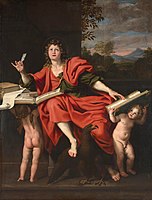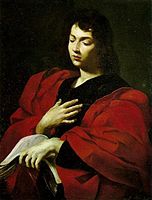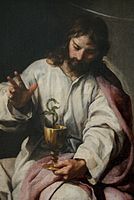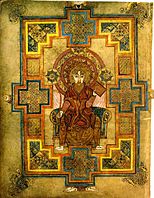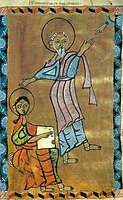
John the Evangelist
John the Evangelist[a] is the name traditionally given to the author of the Gospel of John. Christians have traditionally identified him with John the Apostle, John of Patmos, and John the Presbyter,[2] although this has been disputed by most modern scholars.[3]
John the Evangelist
Between c. AD 6–9
c. AD 100[1]
27 December (Western Christianity); 8 May and 26 September (Repose) (Eastern Orthodox Church)
Eagle, Chalice, Scrolls
- Gospel of John (traditional attribution)
- Epistles of John (traditional attribution)
- Revelation (traditional attribution)
Feast day[edit]
The feast day of Saint John in the Catholic Church, Anglican Communion, and the Lutheran Calendar, is on 27 December, the third day of Christmastide.[25] In the Tridentine calendar he was commemorated also on each of the following days up to and including 3 January, the Octave of the 27 December feast. This Octave was abolished by Pope Pius XII in 1955.[26] The traditional liturgical color is white.
Freemasons celebrate this feast day, dating back to the 18th century when the Feast Day was used for the installation of Grand Masters.[27]
In art[edit]
John is traditionally depicted in one of two distinct ways: either as an aged man with a white or gray beard, or alternatively as a beardless youth.[28][29] The first way of depicting him was more common in Byzantine art, where it was possibly influenced by antique depictions of Socrates;[30] the second was more common in the art of Medieval Western Europe and can be dated back as far as 4th-century Rome.[29]
In medieval works of painting, sculpture and literature, Saint John is often presented in an androgynous or feminized manner.[31] Historians have related such portrayals to the circumstances of the believers for whom they were intended.[32] For instance, John's feminine features are argued to have helped to make him more relatable to women.[33] Likewise, Sarah McNamer argues that because of John's androgynous status, he could function as an 'image of a third or mixed gender'[34] and 'a crucial figure with whom to identify'[35] for male believers who sought to cultivate an attitude of affective piety, a highly emotional style of devotion that, in late-medieval culture, was thought to be poorly compatible with masculinity.[36]
Legends from the "Acts of John" contributed much to medieval iconography; it is the source of the idea that John became an apostle at a young age.[29] One of John's familiar attributes is the chalice, often with a snake emerging from it.[37] According to one legend from the Acts of John,[38] John was challenged to drink a cup of poison to demonstrate the power of his faith, and thanks to God's aid the poison was rendered harmless.[37][39] The chalice can also be interpreted with reference to the Last Supper, or to the words of Christ to John and James: "My chalice indeed you shall drink."[40][41] According to the 1910 Catholic Encyclopedia, some authorities believe that this symbol was not adopted until the 13th century.[41] There was also a legend that John was at some stage boiled in oil and miraculously preserved.[42] Another common attribute is a book or a scroll, in reference to his writings.[37] John the Evangelist is symbolically represented by an eagle, one of the creatures envisioned by Ezekiel (1:10)[43] and in the Book of Revelation (4:7).[44][41]

